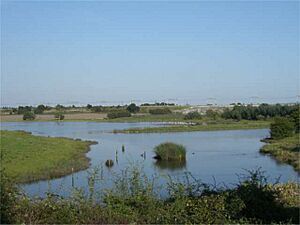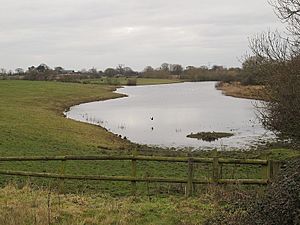Sandbach Flashes facts for kids
The Sandbach Flashes are a special group of 14 wetlands located west of Sandbach in Cheshire, England. These unique shallow lakes, known as "flashes," were officially named a Site of Special Scientific Interest (SSSI) in 1963. This means they are very important for their wildlife and geology. The total area of these flashes is about 1.53 square kilometers.
Some of the individual flashes you can find here include Bottom's Flash, Crabmill Flash, Elton Hall Flash, Fodens Flash, Groby's Flash, Ilse Pool, Moston Flashes, Pump House Flash, Railway Flash, Red Lane Tip and Pool, and Watch Lane Flash. A special group called the Sandbach Flashes Joint Management Committee helps look after part of this amazing site.
Contents
About Sandbach Flashes
The Sandbach Flashes are a collection of pools that formed because the ground sank. This sinking happened due to salt dissolving deep underground. The water in these flashes can be very different. Some flashes have freshwater, much like other lakes in Cheshire. Others have very salty water.
Most of the flashes are surrounded by grassland. This grassland has been changed a bit by farming. Fodens Flash is special because it has some wet woodland around it.
Amazing Plants and Animals
Inland salty places like the Sandbach Flashes are very rare in Britain. They are home to unusual groups of plants and animals that can live in these special conditions.
Because the flashes are different ages, depths, and have different water types, they have many different plant and animal communities.
Plants of the Flashes
The newest flashes have small, spread-out patches of plants that grow out of the water. These are mostly great reedmace (Typha latifolia) and sometimes lesser pond-sedge (Carex acutiformis). The older flashes have large areas of common reed (Phragmites australis).
At Fodens Flash, the plants growing out of the water slowly change into a fen (a type of wetland) and wet woodland. This woodland is mostly made up of alder (Alnus glutinosa) and willow trees (Salix species). A plant called wood small-reed (Calamagrostis epigejos) grows a lot on the ground here.
Sometimes, parts of the area get flooded. In these spots, you can find plants like water-pepper (Persicaria hydropiper), plicate sweet-grass (Glyceria plicata), and celery-leaved water-crowfoot (Ranunculus sceleratus). A rare plant in Cheshire, Shore-weed (Littorella uniflora), also grows here.
The saltier flashes get their water from natural salty springs. These flashes have plants that can handle salty water. Examples include spiked water-milfoil (Myriophyllum spicatum), fennel-leaved pondweed (Potamogeton pectinatus), and horned pondweed (Zannichellia palustris). You can also find a type of green alga called Enteromorpha intestinalis.
Next to these salty flashes are areas of saltmarsh. These areas have plants like sea aster (Aster tripolium), lesser sea-spurrey (Spergularia marina), and reflexed saltmarsh-grass (Puccinellia distans).
Animals of the Flashes
Many unusual aquatic invertebrates (animals without backbones that live in water) live in the flashes. These include the mayfly Caenis robusta and the snail Gyraulus laevis. There are also creatures that like salty water, such as the water boatmen Sigara concinna and S. stagnalis, and the shrimps Gammarus duebeni and G. tigrinus.
The flashes are very important for wildfowl (water birds) and waders (birds that wade in shallow water). Many of these birds visit as migrants or during winter. The main types of birds you might see are wigeon, teal, lapwing, and snipe.
The woodland at Fodens Flash is also home to many different types of lichen.



